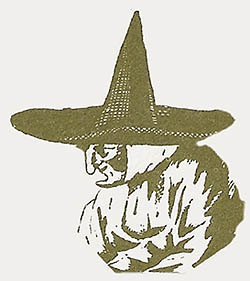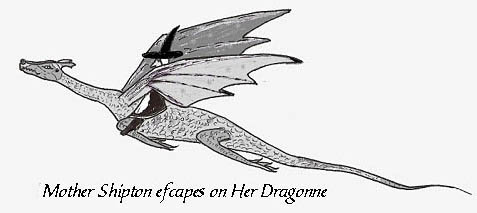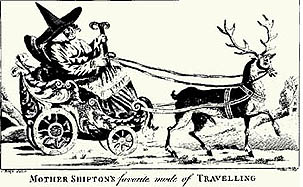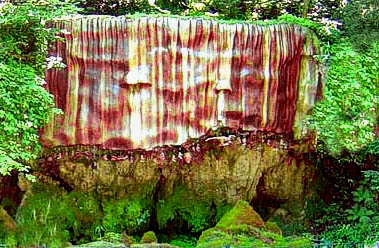Mother Shipton: England's Nostradamus
by Gareth Evans
Situated beside the River Nidd some 16 miles west of York, Knaresborough has been described as one of North Yorkshire's most picturesque towns. First mentioned in the Domesday Book of 1086/7 as "the Manor of Chenaresburg", the town today reflects this long legacy, offering the visitor a variety of sights -- including a castle, the oldest chemist's shop in England, and a wealth of historic buildings and architectural styles.
A short distance from the town itself, in what was once the heart of the Ancient Forest of Knaresborough, lies the Dropping Well. First put on view to the public in 1630, this is England's oldest tourist attraction.
However, the site has an even older claim to fame: 142 years earlier, in a small cave nearby, an unmarried 16-year-old died in childbirth. It was an unremarkable event in those days, but the baby girl she produced would grow to be both feared and revered in her own time and remembered over the centuries as England's greatest prophetess -- Old Mother Shipton, the English Nostradamus.
Birth and Childhood
In a time when most of the population was illiterate and books still something of an expensive luxury despite the advent of the printing press, the early stories of Mother Shipton's life would have been passed on by word of mouth and doubtless embellished in the telling beside countless hearths. As a result, there are many versions of how Mother Shipton -- Ursula Southeil -- was born and spent her childhood. It is generally accepted that she was born one night in the summer of 1488, to the young Agatha Southeil (or possibly Sontheil), who was barely 16 years old.
 According to some of the accounts, this birth was accompanied by "strange and terrible noises." The woman who acted as midwife is said to have reported a great crack of thunder and a pungent smell of brimstone at the moment Ursula appeared into the world. However, since most suggest that the birth was unattended, this version may have been a later fabrication to fit in with the fanciful notion that the devil himself had been the child's father, a story that grew up as news of Ursula's abilities spread. In all probability the truth of the child's paternity has a far more mundane and earthly explanation. Agatha was generally recorded as an orphan of "slothful and idle" tendencies, who had been subject to the scorn and derision of local women for her loose morals, and there is some evidence that while she was pregnant, she may have been tried as a common prostitute.
According to some of the accounts, this birth was accompanied by "strange and terrible noises." The woman who acted as midwife is said to have reported a great crack of thunder and a pungent smell of brimstone at the moment Ursula appeared into the world. However, since most suggest that the birth was unattended, this version may have been a later fabrication to fit in with the fanciful notion that the devil himself had been the child's father, a story that grew up as news of Ursula's abilities spread. In all probability the truth of the child's paternity has a far more mundane and earthly explanation. Agatha was generally recorded as an orphan of "slothful and idle" tendencies, who had been subject to the scorn and derision of local women for her loose morals, and there is some evidence that while she was pregnant, she may have been tried as a common prostitute.
In most versions of the story, Agatha dies in childbirth, her body being found the next day beside the newborn Ursula, a child universally described as grotesquely deformed. Her head was too large, with "goggling" eyes that glowed like embers; her cheeks were sunken; her teeth -- she seems to have been born with a full set -- protruded like the tusks of a boar; and her limbs were twisted and ill-formed.
A kindly townswoman took in this decidedly unprepossessing bundle, though at times she might have had reason to wonder if she had done the right thing. Most of the earliest tales of Ursula herself tell of the mischief she wrought on her foster mother, and strange events are said to have plagued the cottage as the child grew up. The furniture would mysteriously rearrange itself, plates be flung about and food vanish before the eyes of astonished mealtime guests. On one occasion, Ursula's adoptive mother returned home to find her door wide open and dreadful wailings issuing from inside the house. Once inside, with the support of her neighbours and the local priest, she discovered her house ransacked, the cradle empty and the naked infant sitting astride the cooking bar above the hearth, chuckling happily. Another tale tells how a gathering of her friends in the kitchen were attacked by unseen forces, which tied all the men present to one of the roof beams, from which one of the women hung by her toes. The remainder of the women were forced to dance in wild circles and an imp in the form of a black monkey urged on any who flagged with pricks from a large pin. Throughout all, it is said, Ursula sat in her cradle, serenely floating in mid-air.
Why these fanciful tales arose, whether to excuse a fearful foster mother who sought respite (perhaps through absence or alcohol) from her undoubtedly difficult charge, or perhaps later to create some air of diabolical intrigue, will never be certain. Whatever their origins, however, they clearly enhanced the Mother Shipton mystique, though the exploits of her later life were to cement this far more firmly.
A Growing Reputation
A quick, bright girl, Ursula was forced to endure merciless cruel taunts from the local children over her appearance. Despite the records of this great ugliness and temper, both of which are said to have grown worse as she herself grew, a carpenter by the name of Toby Shipton courted the young Ursula. They married in 1512.
Even as a young woman, Ursula had already begun to gain something of a reputation as a soothsayer. This reputation extended beyond her local area -- people traveled to Knaresborough from some distance around to consult her. When this sadly deformed creature made such a good marital "catch", the inevitable tale developed that she had used a love-potion to bewitch her hapless suitor. In addition to her redoubtable powers of prophecy, Ursula Southeil, now the respectably married "Mother" Shipton, was clearly also a witch. The real reason that Toby married her is probably, rather like her father's identity, far less exotic. Although her appearance -- recorded as "a body larger than common, and crooked with a face frightful to look upon" -- well suited her to play the role of the witch of contemporary popular imaginings, she is also described as "extraordinary" in her compassion and understanding. Possibly Toby saw the truth in the old adage about the shallow veneer of physical beauty.
Perhaps it was this remarkable understanding, which the contemporary recollections seem to report, that was at the heart of her insight. She seems to have been particularly successful in solving the sort of interpersonal disputes that must have been as commonplace then as now and few appeals for help from wronged townsfolk went unresolved. This pattern seems to have been established very early in her married life and continued until her death. Thieves would publicly return stolen goods, apologising to the astonished owners for their sin; wandering husbands would beg forgiveness and mend their ways; corrupt officials would make spontaneous acts of restitution.
It is easy to see how she might have used an insider's knowledge of her neighbours -- and perhaps a measure of coercion -- to bring about these results and perhaps even apparently to "predict" the future within the confines of her own small community. For an astute woman, as she undoubtedly was, the signs of blooming love, illness and death are always there to be read. However, some of her prophesies cannot be explained away so readily, although her habit of making them in riddles, as her close contemporary Nostradamus had done, does rather leave some of them open to a fair degree of "interpretation" after the fact. Nevertheless, her words are said to have foretold much of the future history of England, including Drake's defeat of the Spanish Armada (1), the execution of Mary, Queen of Scots (2), and the succession of James VI of Scotland (and I of England) and union between the two countries (3). Over 105 years after her death, as the Great Fire of London began just a year after the ravages of the Great Plague, the famous diarist Samuel Pepys wrote "See -- Mother Shipton's word is out." Ursula, it seems, had seen this too. It also said that she predicted the time of her own death -- supposedly to the very day and hour.
The Ruin of Cardinal Wolsey
Inevitably, in a time of enormous religious turbulence, when the accusation of heresy was tantamount to a death sentence and witchcraft feared by high and low born alike, Mother Shipton gained enemies as readily as she amassed her enduring reputation. Probably the most famous of these was Cardinal Wolsey, Henry VIII's Chancellor and prime architect of the dissolution of the monasteries -- whom she had dubbed "the Mitred Peacock". It is clear from many stories of Ursula's life that she had no love of vain, pompous, self-important dignitaries -- a principle which, it seems, she applied even-handedly without fear or favour. She prophesied the Cardinal's downfall, just as she had the Mayor of York before him.
Understandably, this did little to endear her to what was then the most powerful man in England after the King, particularly in the turbulent times surrounding the impasse over Henry's marriage to Anne Boleyn. With the Pope holding firm, Wolsey, who was probably already fearful of his own future, can hardly have welcomed the gloomy prediction that, although he was Archbishop of York, he would never enter the city. He retaliated by threatening that when he did come to York, he would have Mother Shipton publicly burned at the stake as a witch. There is an account of a nocturnal visit, prior t his arrival at York, from three of Wolsey's retinue -- the Duke of Suffolk, the Earl of Northumberland, and Lord D'Arcy -- to encourage her to see reason. Ursula is said to have tested her own fate by throwing her staff onto the fire. When it remained miraculously unburnt, she concluded that so would she.
Some time later, Wolsey arrived at Cawood, a village a few miles outside of York, his last stop before entering the city. He is said to have climbed the tower at Cawood Castle -- which remains to this day -- in an attempt to see his destination in the distance in defiance of the prophecy. He forgot, however, that Mother Shipton had not said that he would never see York, only that he should never reach it. Nor did he; he was arrested on a charge of treason by the very same Earl of Northumberland, took ill on the journey south, and died.
The medieval tower Wolsey is said to have climbed can still be seen today, standing as part of an otherwise ordinary street in Cawood.
Stags, Goblins and Dragons
As a curiosity of the age, Mother Shipton's private life was seldom her own. It is said that when pushed beyond the limits of her notoriously limited patience, she would send goblins to put some of her worst tormentors to flight. On one occasion she found herself before the local magistrate as a result. Promising worse things to come if she were not left unmolested, she is alleged to have called out "Updraxi, call Stygician Helluei" in a loud voice. A dragon answered her summons and flew her away from the court room and back to the safety of her own home. An engraving appeared in 1795 showing this remarkable feat, supposedly drawn from contemporary records -- though since Ursula had died nearly 250 years earlier, this seems unlikely. There is an equally improbable illustration of Mother Shipton riding in a carriage drawn by a stag, which had appeared in The Wonderful Magazine two years earlier. Such engravings, while of dubious accuracy, fed the myth and mined a rich vein of public fascination, which remains to this day.

Her Legacy
Mother Shipton is credited with predicting many aspects of everyday life that would have seemed outrageous and inconceivable in her time -- motor-cars and trains (4), iron ships (5), submarines (6), aircraft (7), and telegraphy (8), and possibly by extension, even the Internet. However, it is now widely accepted that many of these apparently prophetic writings were the work of a man by the name of Hindley, writing in 1871, which does somewhat change their apparently "visionary" nature. In addition, as crowds celebrated 1 January 2000 across the globe, her most portentous prediction of all -- the end of the world -- was shown to be wrong.
Of course, some of her supposed prophetic gift is open to more mundane explanation. Undoubtedly people were simpler in her times, perhaps more easily influenced and more prepared to believe a supernatural explanation. It is also true that some of the words ascribed to her are obscure enough and framed so loosely as to enable them to be interpreted to apply to almost any subsequent event. Her apparent foreknowledge of Wolsey's fall and her accurate forecast of the fate of her noble visitors, the Earl of Northumberland and his friend Lord D'Arcy -- to die on the pavements of York -- might well have been the result of a shrewd understanding of the politics of the day. However, it is less easy to explain away her other predictions, such as the successions of English monarchs, the wars and major historical events of their reigns.
 With a character as colourful as hers, and in days long before comprehensive written records, discerning fact from fiction is always challenging. Many other parts of Britain have tried to claim her as their own over the years, including Melrose, Winslow-cum-Shipton in Buckinghamshire, and Great Yarmouth. Some accounts suggest she died in 1651, but since this would have made her 163 years old, it is probably simply a juxtaposition of the more usually accepted date of 1561. The first written record of her life was in a pamphlet written in 1641, which associated her with York, or possibly Yorkshire. Her supposed likeness appears on the cover, but this drawing, though coarsely executed, has none of the jutting chin, hooked nose, hump or tall black hat evident in later versions. By 1663, in an illustrated manuscript telling the tale of Wolsey on Cawood Tower, the image of Mistress Shipton as a respectable woman of her time has irreversibly metamorphosed into the "Old Mother" image of the archetypical, iconic witch. Ironically, it is this image that has given her perhaps the most unlikely legacy of all: Callistege mi -- the Mother Shipton Moth -- bears the profile of her hook-nosed face, silhouetted on its wings.
With a character as colourful as hers, and in days long before comprehensive written records, discerning fact from fiction is always challenging. Many other parts of Britain have tried to claim her as their own over the years, including Melrose, Winslow-cum-Shipton in Buckinghamshire, and Great Yarmouth. Some accounts suggest she died in 1651, but since this would have made her 163 years old, it is probably simply a juxtaposition of the more usually accepted date of 1561. The first written record of her life was in a pamphlet written in 1641, which associated her with York, or possibly Yorkshire. Her supposed likeness appears on the cover, but this drawing, though coarsely executed, has none of the jutting chin, hooked nose, hump or tall black hat evident in later versions. By 1663, in an illustrated manuscript telling the tale of Wolsey on Cawood Tower, the image of Mistress Shipton as a respectable woman of her time has irreversibly metamorphosed into the "Old Mother" image of the archetypical, iconic witch. Ironically, it is this image that has given her perhaps the most unlikely legacy of all: Callistege mi -- the Mother Shipton Moth -- bears the profile of her hook-nosed face, silhouetted on its wings.
Mother Shipton was said to have been buried in unconsecrated ground somewhere in the outskirts of York, possibly between the villages of Clifton and Shipton. A stone monument was supposed to have been erected on the site, bearing the inscription "Here ly's she who never ly'd, Whose skill often has been try'd, Her prophecies shall still survive, And ever keep her name alive." Some time later, according to local folk lore, the stone was removed to a museum in York, from whence it subsequently disappeared. Its whereabouts today are unknown. [Editor's Note: An alert reader has pointed out that the former location of the stone can be seen on an 1852 map of York - visit http://www.york1852.org/ and scroll to the upper left corner of the map. (Follow Bootham road out of the city to the north-west, until you reach the Y-junction.)]
Historic Knaresborough
The long tenure of the town beside the river Nidd has guaranteed Knaresborough its fair share of historical interest. Hugh de Morville, the leader of the four knights who murdered Thomas 1 Beckett in 1170, was Constable of the Castle of Knaresborough; Edward III visited the town; for a time, Guy Fawkes lived in it; Oliver Cromwell once slept in a fishing lodge. There has been a market in the town since 1206, which was formally established under a charter granted by Edward II in 1310, making Wednesday the official market day.
The Castle
Today a ruin, the first fortification of the site took place in Norman times, established by Serlo de Burg, who had been granted the Manor in return for his assistance in William the Conqueror's invasion. His original castle was extensively rebuilt in the 14th Century. In 1399, King Richard II was held here briefly on his way to Pontefract and his ultimate murder the following year. A staunch Royalist stronghold throughout the English Civil War, it was captured on 20th December 1644 after a short siege, and subsequently destroyed by order of Parliament.
The Dropping Well
Now more usually known as the Petrifying Well, this ancient geological curiosity is reputed to be the only one of its kind in England and is the country's oldest visitor attraction. The extraordinarily high mineral content of the water, flowing from an underground aquifer, leaves encrusting deposits on the face of the well itself, as well as on anything placed in the flow. In Mother Shipton's day, the apparent ability of this well to turn things to stone made it the subject of much superstition -- and an ideal venue for her birth and subsequent life. Mother Shipton's cave is part of the same site.

The Petrifying Well.
The water flows down the face of the well, leaving deposits; the two protrusions visible from the rock face are actually a man's top hat and a lady's hat placed there in the 1800's. The objects danging from the lip of the well are toys and other items that have been placed there to be "petrified" -- similar petrified items can be viewed in the museum shop.
The Oldest Chemyst Shoppe in England
Established in 1720, England's oldest chemist shop stands in the heart of Knaresborough. Resplendent with its "bleeding couch" -- used during the applications of leeches -- and wonderful collection of original bottles, powders and crystals, it offers a unique window on the history of English medicine.
Location
Knaresborough is in North Yorkshire, some 16 miles west of York and roughly the same distance northeast of Leeds. Mother Shipton's cave and the Petrifying Well lie off the A59 Harrogate to York Road, a short distance from the A1 (M). The site is clearly signposted on this approach, as well as from the A616/A658 roundabout if approaching from Leeds.
References to Prophecies
- "The maiden Queen full many a year, Shall England's warlike sceptre bear........ And the Western monarch's wooden horses, Shall be destroyed by Drake's forces"
- "A Widowed Queen, In England shall be headless seen."
- "The northern line of Tweed, The maiden Queen shall next succeed, And join in one, two, mighty States"
- "Carriages without horses shall go"
- "Iron in the water shall float, As easy as a wooden boat"
- "Under water men shall walk, Shall ride, shall sleep, shall talk"
- "In the air men shall be seen"
- "Around the world thoughts shall fly, In the twinkling of an eye"
More Information:
We regret that we no longer have the resources to maintain up-to-date links and/or hours and pricing details for the various sites and attractions listed on this website. For more information about the location(s) listed above, please use your favorite search engine or visit Wikipedia.
Gareth Evans is a freelance writer and photographer, having previously worked in the private sector before lecturing at the University of Durham. Having travelled extensively, he now concentrates on writing about subjects much closer to home -- both geographically and metaphorically. He is particularly interested in myths, legends and folklore, together with the often forgotten history of the Celtic lands, especially that of his own native Wales and Scotland, his adopted home. Gareth is currently planning his next book, looking at the role of the pagan Horned God in myth and history.
Article and photos © 2005 Gareth Evans
|
